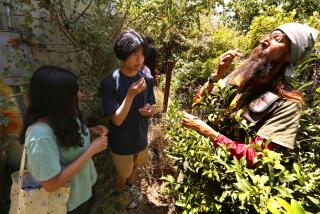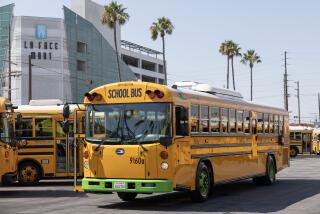Ideals Are Swell, but Classrooms Are Better
It’s 6 o’clock in the morning and Coby Ruth, 11, is sitting in the dark on Vermont Avenue in Los Angeles, using the yellow glow from a lamppost to finish a writing assignment for his English class.
Coby had crawled out of bed at 5 sharp in Echo Park, where he caught an MTA bus to Virgil Junior High. Like many other Los Angeles Unified School District campuses, Virgil is ridiculously overcrowded. So Coby waits outside the school for a bus that will schlep him across the city to Emerson Junior High in West L.A.
For the record:
12:00 a.m. May 2, 2004 For The Record
Los Angeles Times Sunday May 02, 2004 Home Edition Main News Part A Page 2 National Desk 0 inches; 19 words Type of Material: Correction
Lopez column -- An April 14 Points West column by Steve Lopez identified singer Harry Belafonte as Henry Belafonte.
How long you been doing this? I ask.
“Two years,” he says, telling me he won’t get home until after 4:30 p.m.
Why didn’t you do your homework last night? I ask as he puts pencil to paper.
“I have a new baby sister,” he says, and he went to the hospital to see her.
By the time the sun comes up, Coby is lost in a gathering crowd. Hundreds of other students are milling on the sidewalk along Vermont as cars blow by. Some students are dropped off by parents, others come by MTA bus.
Some live frustratingly close to Virgil -- as little as two blocks away. But the school was built for 1,994 students and already has 2,791. So yellow school buses line up every morning to shuttle the overflow to schools in Chatsworth, Sherman Oaks and other far-flung destinations that can take well over an hour to reach.
After watching the choreography of this daily shuttle, I headed over to the long-vacant Ambassador Hotel on Wilshire Boulevard, where the LAUSD plans to build a K-12 school on the sprawling property that figures in so much L.A. history and lore.
The school would ease overcrowding at several surrounding schools and save roughly 3,800 students and their parents the daily madness of long commutes. But as you might have guessed, getting the school built without lawsuits, if not fisticuffs among dozens of well-intentioned business and community groups, may require more than hall monitors.
Preservationists and school district officials have bickered for months about whether it’s possible to salvage the decomposing hotel. The Los Angeles Conservancy would like to see most or all of the Ambassador saved in its conversion to a school.
Foes argue that knocking the hotel down and starting from scratch would save as much as $95 million and allow the new school to open its doors a year sooner than a rehab would.
School board member Mike Lansing argues that even a partial salvaging of the hotel would cost an additional $20 million to $30 million and require such an extensive gutting, the hotel would be a skeleton of itself. So why bother?
“You’re talking about preserving a facade,” said Lansing, who joked that it could only happen in Hollywood. You could fix a lot of school roofs, playgrounds and cafeterias for $30 million, he said.
But Linda Dishman and Ken Bernstein of the Los Angeles Conservancy wanted to give me a tour of the Ambassador before I came down on Lansing’s side. And so they met me at the hotel along with Edwin J. Van Ginkel, one of the school district officials they’ve been at odds with.
This is the hotel, of course, where Robert F. Kennedy was assassinated in 1968. Every president from Hoover to Nixon stayed at the Ambassador. F. Scott Fitzgerald wrote here, six Academy Awards shows were held here, and the Cocoanut Grove stage was graced by Frank Sinatra, Judy Garland, Henry Belafonte and Sammy Davis Jr.
We started in the casino-style corridor of shops, then made our way to the grand high-ceilinged lobby, which would be a student center under the preservationists’ plan. Then we visited the main ballroom, which would be transformed from a dark and musty relic into a library.
In the pantry where Kennedy was shot by Sirhan Sirhan, I told the others about having met Juan Romero, the East L.A. busboy who knelt at Kennedy’s side and stuffed rosary beads into his hands.
“It’s one of the most seminal buildings in Los Angeles,” Bernstein said when our tour ended, arguing that the Ambassador’s past as a historic and cultural landmark can help inspire students.
I’d love to see it preserved, I said. Especially since we live in such a throwaway culture and have paved over, or neglected, so much of L.A.’s past.
City Councilman Martin Ludlow, who is trying to forge a compromise, sees the Ambassador as a centerpiece in the Wilshire Center corridor, with public access to the sweeping open space that fronts Wilshire. He sees the school as an intersection of past and future. One name that’s been thrown out is the Robert F. Kennedy School for Social Justice.
But Ludlow reached the same conclusion I did regarding the Conservancy and its coalition of 40 community and business groups that place so high a value on the preservation of the Ambassador.
“Show us the money,” Ludlow said.
Whatever the extra cost is to save the hotel, it shouldn’t be paid by L.A. voters. We’ve already done our part for the schools. We’ve approved a whopping $10 billion worth of bonds to build 160 new campuses.
The Conservancy claims the school district’s estimates for the cost of preservation, and the extra time it will take to build the school, are way overblown. If that’s the case, it shouldn’t be difficult to get help from some of the deep pockets in this city.
The list of those who support preservation of the Ambassador begins with the Academy of Motion Picture Arts and Sciences. Somebody over there has to have David Geffen’s phone number.
Preservation is a grand ideal, but here’s the bottom line:
Eleven-year-old Coby Ruth and 3,800 other students are on the street every morning at dawn, waiting for help.
*
Steve Lopez writes Sunday, Wednesday and Friday.
More to Read
Sign up for Essential California
The most important California stories and recommendations in your inbox every morning.
You may occasionally receive promotional content from the Los Angeles Times.











